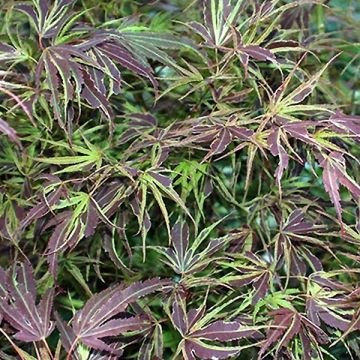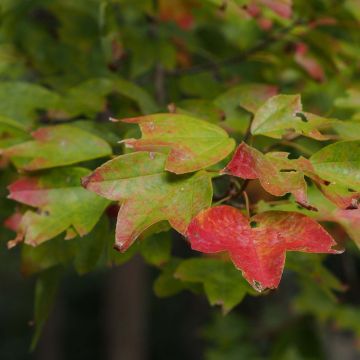

Acer campestre Postelense - Field Maple


Acer campestre Postelense - Field Maple
Acer campestre Postelense - Field Maple
Acer campestre Postelense
Field Maple, Hedge Maple
Special offer!
Receive a €20 voucher for any order over €90 (excluding delivery costs, credit notes, and plastic-free options)!
1- Add your favorite plants to your cart.
2- Once you have reached €90, confirm your order (you can even choose the delivery date!).
3- As soon as your order is shipped, you will receive an email containing your voucher code, valid for 3 months (90 days).
Your voucher is unique and can only be used once, for any order with a minimum value of €20, excluding delivery costs.
Can be combined with other current offers, non-divisible and non-refundable.
Home or relay delivery (depending on size and destination)
Schedule delivery date,
and select date in basket
This plant carries a 24 months recovery warranty
More information
We guarantee the quality of our plants for a full growing cycle, and will replace at our expense any plant that fails to recover under normal climatic and planting conditions.
Would this plant suit my garden?
Set up your Plantfit profile →
Description
Acer campestre 'Postelense' is a variety of field maple which is rare in cultivation. It is a small deciduous tree with a variable habit, rather wide, and shorter than the wild species. It has a slow growth rate but stands out for its yellow foliage, as bright as a forsythia in spring. It will find a place in a collector's garden, placed prominently, or integrated into a field hedge. It is hardy and grows in a wide range of soils, but it dislikes intense sunlight.
Acer campestre 'Postelense' was discovered, in its natural state, by Von Salisch in Postel (Poland) and was first introduced in Germany in 1896. The wild field maple is native to Europe, Asia Minor, and North Africa, and is more of a forest tree than a field tree. The cultivar 'Postelense' develops a rather short trunk topped by a wide, spreading crown, with a variable shape depending on the individual. It has a slow growth rate and will reach a height of less than 5m and form a crown 2.5 to 3m wide if not pruned. The foliage of this deciduous maple consists of smaller leaves than those of the wild species, showing 3 to 5 lobes, attached to the branch by a red petiole. When they appear in spring, their colour is a very bright lemon yellow. In summer, they become greener while retaining a touch of yellow. Autumn and the first cold weather colour the foliage in shades of golden yellow, more or less coppery or orange. The very discreet flowering takes place in spring, at the same time as the leaves emerge. The small flowers are greenish and grouped in corymbs. They are followed by winged, often reddish fruits, called samaras. The wings of this fruit are opposite and perfectly aligned. The field maple forms the hardest wood that can be found in this genus. Its bark is pale grey and fissured. The branches of young individuals often show a corky, ribbed, insulating bark, used for making perches for poultry, which earned it the popular name of "chicken wood".
Field Maple 'Postelense' is an accommodating small tree, it grows in any ordinary soil, even limestone and fairly dry, as long as it is deep enough. The colour of its foliage is less golden, but more beautiful in partial shade. It will be enhanced at the centre of a bed of small shrubs with dark foliage such as Physocarpus 'Little Joker' or Berberis thunbergii 'Concorde', for example. A bed of Geranium 'Rozanne' with long-lasting blue flowers will form a radiant combination with its golden foliage. In a field hedge, it can be mixed with spindles with autumn colours, hawthorns, and ornamental crabapples.
Plant habit
Flowering
Foliage
Botanical data
Acer
campestre
Postelense
Sapindaceae
Field Maple, Hedge Maple
Cultivar or hybrid
Other Acer - Maple tree
View all →Planting and care
Acer campestre 'Postelense' is best planted in spring or autumn in any deep soil, preferably with a tendency towards limestone, in a sunny or semi-shaded position. Once well-rooted, it does not require watering in summer and requires no maintenance. Beware of strong winds. Keep the soil moist during the first two summers after planting. Mulching can be beneficial to save on watering and maintain good soil moisture.
Planting period
Intended location
Care
Planting & care advice
This item has not been reviewed yet - be the first to leave a review about it.
Similar products
Haven't found what you were looking for?
Hardiness is the lowest winter temperature a plant can endure without suffering serious damage or even dying. However, hardiness is affected by location (a sheltered area, such as a patio), protection (winter cover) and soil type (hardiness is improved by well-drained soil).

Photo Sharing Terms & Conditions
In order to encourage gardeners to interact and share their experiences, Promesse de fleurs offers various media enabling content to be uploaded onto its Site - in particular via the ‘Photo sharing’ module.
The User agrees to refrain from:
- Posting any content that is illegal, prejudicial, insulting, racist, inciteful to hatred, revisionist, contrary to public decency, that infringes on privacy or on the privacy rights of third parties, in particular the publicity rights of persons and goods, intellectual property rights, or the right to privacy.
- Submitting content on behalf of a third party;
- Impersonate the identity of a third party and/or publish any personal information about a third party;
In general, the User undertakes to refrain from any unethical behaviour.
All Content (in particular text, comments, files, images, photos, videos, creative works, etc.), which may be subject to property or intellectual property rights, image or other private rights, shall remain the property of the User, subject to the limited rights granted by the terms of the licence granted by Promesse de fleurs as stated below. Users are at liberty to publish or not to publish such Content on the Site, notably via the ‘Photo Sharing’ facility, and accept that this Content shall be made public and freely accessible, notably on the Internet.
Users further acknowledge, undertake to have ,and guarantee that they hold all necessary rights and permissions to publish such material on the Site, in particular with regard to the legislation in force pertaining to any privacy, property, intellectual property, image, or contractual rights, or rights of any other nature. By publishing such Content on the Site, Users acknowledge accepting full liability as publishers of the Content within the meaning of the law, and grant Promesse de fleurs, free of charge, an inclusive, worldwide licence for the said Content for the entire duration of its publication, including all reproduction, representation, up/downloading, displaying, performing, transmission, and storage rights.
Users also grant permission for their name to be linked to the Content and accept that this link may not always be made available.
By engaging in posting material, Users consent to their Content becoming automatically accessible on the Internet, in particular on other sites and/or blogs and/or web pages of the Promesse de fleurs site, including in particular social pages and the Promesse de fleurs catalogue.
Users may secure the removal of entrusted content free of charge by issuing a simple request via our contact form.
The flowering period indicated on our website applies to countries and regions located in USDA zone 8 (France, the United Kingdom, Ireland, the Netherlands, etc.)
It will vary according to where you live:
- In zones 9 to 10 (Italy, Spain, Greece, etc.), flowering will occur about 2 to 4 weeks earlier.
- In zones 6 to 7 (Germany, Poland, Slovenia, and lower mountainous regions), flowering will be delayed by 2 to 3 weeks.
- In zone 5 (Central Europe, Scandinavia), blooming will be delayed by 3 to 5 weeks.
In temperate climates, pruning of spring-flowering shrubs (forsythia, spireas, etc.) should be done just after flowering.
Pruning of summer-flowering shrubs (Indian Lilac, Perovskia, etc.) can be done in winter or spring.
In cold regions as well as with frost-sensitive plants, avoid pruning too early when severe frosts may still occur.
The planting period indicated on our website applies to countries and regions located in USDA zone 8 (France, United Kingdom, Ireland, Netherlands).
It will vary according to where you live:
- In Mediterranean zones (Marseille, Madrid, Milan, etc.), autumn and winter are the best planting periods.
- In continental zones (Strasbourg, Munich, Vienna, etc.), delay planting by 2 to 3 weeks in spring and bring it forward by 2 to 4 weeks in autumn.
- In mountainous regions (the Alps, Pyrenees, Carpathians, etc.), it is best to plant in late spring (May-June) or late summer (August-September).
The harvesting period indicated on our website applies to countries and regions in USDA zone 8 (France, England, Ireland, the Netherlands).
In colder areas (Scandinavia, Poland, Austria...) fruit and vegetable harvests are likely to be delayed by 3-4 weeks.
In warmer areas (Italy, Spain, Greece, etc.), harvesting will probably take place earlier, depending on weather conditions.
The sowing periods indicated on our website apply to countries and regions within USDA Zone 8 (France, UK, Ireland, Netherlands).
In colder areas (Scandinavia, Poland, Austria...), delay any outdoor sowing by 3-4 weeks, or sow under glass.
In warmer climes (Italy, Spain, Greece, etc.), bring outdoor sowing forward by a few weeks.

























































